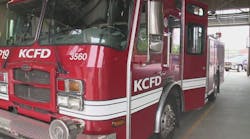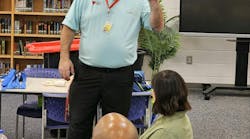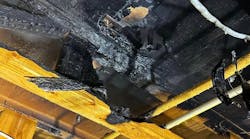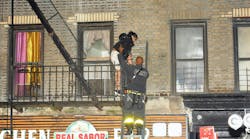Media accounts from the "Motor City" suggested a slight increase with 142 fires over the three-day period from "Devil's Night" through Halloween and into Saturday morning. Another account listed 158 fires, a drop from 354 incidents in 1994. Some fires this year were blamed on windy weather and falling power lines. Vacant homes and garages bore the brunt of structural responses in Detroit.
Camden's 250-member fire department, which fields eight engines, three ladders and one rescue company, experienced numerous structure fires this year with an estimated 60 runs on "Mischief Night," according to Battalion Chief Joseph Marini. Unlike previous years (Camden's worst deluge was 1991), fire officials in 1996 canceled mutual aid staging of volunteer companies at city firehouses. The influx of outside help grew from a heavy workload in the early 1990s in 1992, some 135 mutual aid companies rolled into the city from as far away as Middlesex County in northern New Jersey. Rain cut that night's arson short.
In 1996, activity stretched from the normally busy North and East Camden areas to South Camden, where blazes in row frames and a large Queen Anne dwelling taxed units. By 9 P.M. on Mischief Night, palls of smoke from a half-dozen "all-hands" blazes blanketed the riverfront city. Special "second section" engine companies made up of career members and chiefs shared quarters with first-due apparatus. If initial units found work at one location, help was sent but the backup units stayed put, ready to respond to additional incidents in first-response districts. The volunteer mutual-aid plan remained as it does on any normal night.
Basing its battle plan on prevention measures that brought Detroit success, Camden relies heavy on the community, police support and fire investigators. The method can be used by any fire department seeking to keep a lid on forecasted "trouble period" arson. The steps are simple with their success lying in a cooperative venture between citizens and government. One can't exist without the other.
Detroit demolished over 800 vacant buildings and removed 2,000 abandoned vehicles. Federal officers from many agencies like the FBI, Bureau of Alcohol, Tobacco and Firearms (ATF) and Secret Service joined 30,000 residents on patrol. A City Council ordinance prohibits the sale of gasoline or other fuels in portable containers during a targeted time period. Yellow emergency lights placed atop vehicles increased the eyes of the law on the neighborhood level. Arrests for curfew violations continued to make an impact.
Figures released by the Detroit Fire Department show a major facelift since 1984's three-day tally of 810 responses. Ten years later, there were 354 incidents.
Camden's traditionally depressed nature forces ally draining preventative actions to the back burner. Under the direction of Chief Fire Marshal Herbert Leary, investigators check vacant buildings 24 to 48 hours prior to Mischief Night for stockpiles of accelerants. That continues throughout the target date as teams aggressively search abandoned dwellings, watch for suspicious activity and patrol trouble areas. Work crews begin sealing the first level of vacant structures at the beginning of October.
"We have 3,000 vacants," Marini said. Camden does not seal structurally deficient buildings for safety reasons. Demolition, which Marini said averages $10,000 per unit, isn't an option.
On Patrol
Camden investigators find diverse duty throughout the city. During Mischief Night 1994, Leary hit the streets and didn't return to his downtown headquarters until 2 A.M. He cruised the hot spots and learned that finding pre-Halloween trouble in Camden isn't hard. Situations range from rubbish fires to teens congregating on corners with some picking parked cars as a way to slip through the curfew crack.
Pulling up beside one occupied car Leary requested police and asked the driver for his name and address. The brazen man hollered: "What do you want to know that for?" The veteran investigator responded: " 'Cause I want to send you a Christmas card!"
A few minutes later, East Camden units responded to a fully involved turn-of-the-century mansion. Shots were fired at units dousing a car fire. An engine responding to the working fire collided with a car. Police asked Leary to respond to a rowhouse near a desolate North Camden intersection. Three liquor bottles filled with an accelerant were fished out of the debris-strewn interior.
In South Camden a volunteer unit from Brooklawn arrived to find a fire in the living room of a rowhouse and a bonfire in the side yard. Leary grabbed a hoseline and opened up on the front room, quelling the blaze. "That felt good. I never get tired of this," he said, smiling as he passed the 11/2-inch line to another firefighter.
A problem in Camden is the regional media's coverage of Mischief Night activities. Many send camera crews to film the larger blazes but under-report the seriousness of the time-consuming smaller fires that drain the stamina of firefighters. There's no question that responses have declined from the horrific number in 1991. "Back then, we were getting two to three fires every minute," Marini recalled.
Television editors condense Mischief Night to a two-minute sound bite of resident patrols and the featured blaze. They eagerly report a decrease in incidents, regardless of the fact that the amount of activity is far above the normal daily tally. Arson frustrates firefighters. Media attention disappears on Halloween night and the following day, when firefighters continue to deal with residual arson.
Again, South Camden bore the brunt of the 1996 attack. Serving in the field in a battalion, Marini arrived on scene to find a well-involved 100-by-60-foot commercial building. "It was as the British say 'about 75 percent alight,' " Marini mused. Shortly thereafter, companies attacked a serious blaze in a house at 8th and Bailey streets.
A rally of community spirit and tactical application of resources seems to be helping America's most troubled Mischief Night cities. Analyzing police intelligence and shadowing first-in units with replacement companies draws more resources to sectors taking the heat. But success still comes down to resident pride and dedicated firefighters. "We're doing everything possible to save our city and protect our firefighters," Camden Chief Kenneth Penn said.
While volunteer firefighters in suburban Camden found their services less in demand in 1996, volunteer attorneys found needy recipients for their skills in Detroit's judicial system. They were on hand to represent more than 90 teens charged with Devil's Night curfew violations.
Joseph Louderback, a Firehouse® contributing editor, served as editor of the FDNY's Publications Unit and as a government affairs reporter. He is a 20-year member of the Milmont Fire Company in Milmont Park, PA, and conducts media relations programs for the fire service.














